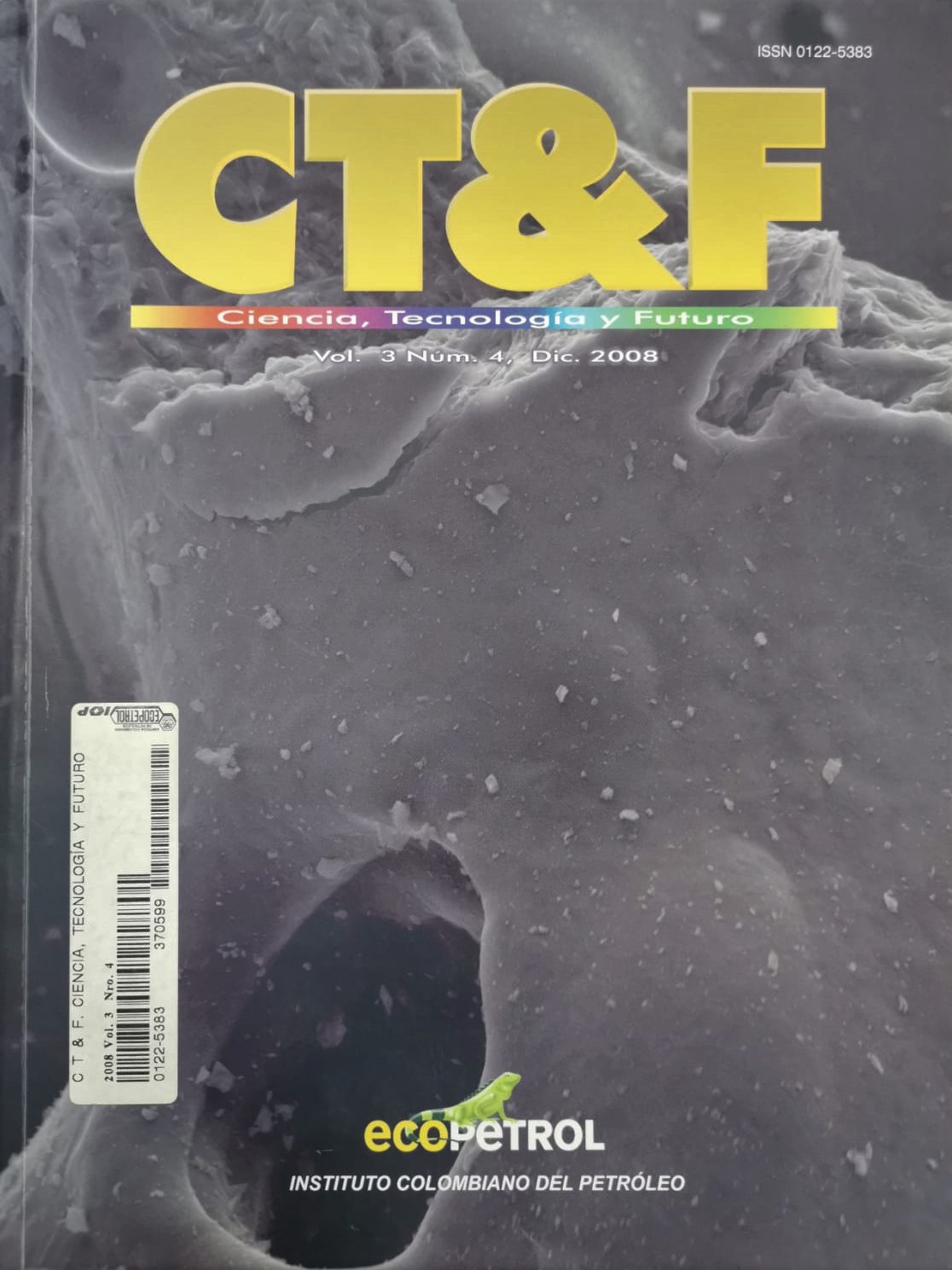Síntesis y caracterización de un copolímero de injerto a partir de asfalteno mediante espectroscopia FT-IR
Resumen
La creación de nuevos compuestos poliméricos para ser adicionados al asfalto, ha llamado la atención de manera considerable debido a que estas sustancias han logrado modificar las características reológicas y propiedades físicas del asfalto, con la finalidad de mejorar su comportamiento en el tiempo de uso. El presente trabajo explica, la síntesis de un nuevo copolímero de injerto a partir de una fracción del asfalto llamada asfalteno, la cual es modificada con anhídrido maleico. Paralelamente se realiza la funcionalización del poliestireno, resina polibencilamina, esta posee un grupo amina - NH2 libre que reacciona con los grupos anhídro, injertados en el asfalteno, y así obtener el nuevo copolímero de injerto Poliestireno/Asfalteno.
Referencias bibliográficas
Akelah, A., & Sherrington, D. C. (1981). Application of Functionalized Polymers in Organic Synthesis. Chem. Rev., 81(6), 557-587. https://doi.org/10.1021/cr00046a003
An, Q. F., Quian, J. W., Sun, H. B., Wang, L. N., Zhang, L., & Chen. H. L. (2003). Compatibility of PV/ EVA blends and the pervaporation of their blends membranas for benzene/ cyclohexane mixtures. J. of Membrana Science, 222 (1-2), 113-122, September. https://doi.org/10.1016/S0376-7388(03)00260-6
ASTM D-3279. (1990). Standard Test Method for n-Heptane Insoluble.
ASTM 4124. (1991). Standard Test method for Separation of Asphalt Into for Fractions.
Becker, Y., Méndez, M. P, & Rodríguez, Y. (2001). Polymer modified asphalt, Vis. Technol, 9 (1), 39-50.
Belfer, S., & Glozman, R. (1979). Anion Exchange Resins Prepared from Polystyrene Crosslinked Via a Friedel- Crafts Reaction. J. Appl. Pol. Sci, 24: 2147-2157. https://doi.org/10.1002/app.1979.070241007
Billmeyer, F. W. (1971).Texbook of polymer science, 84-90.
Bosch, P., & Mateo, J. L. (1993). Revista de Plásticos Modernos, 422, 443, 444. Abril, Mayo y Junio.
Bouldin, M., & Collins, A. (1990). Rheology and Micro- Structure of Polymer. Asphalt Blends, Shell Development Co. Meeting of Rubber Division, ACS, Las Vegas.
Brule, B. (1996). Polymer-modified asphalt cements used in the road construction industry: Basic principles. Transportat Res. Record 1535. https://doi.org/10.1177/0361198196153500107
Chen, J. S., Liao M.C., & Shiah, M. S. (2002). Asphalt modified by styrene-butadiene-styrene triblock copolymer: Morphology and model. J. Mater. Civil Engin. 14 (3), 224-229. https://doi.org/10.1061/(ASCE)0899-1561(2002)14:3(224)
Cho, K., Hoon Seo, K., & Oanahn, T. (1997). Enhancement of interfacial adhesion between polystyrene and styrene maleic anhydride random copolymer via reactive reinforcement. Poliymer, 38 (19), 4825-4830. https://doi.org/10.1016/S0032-3861(97)00012-8
Collins, E. A. (1973). Experimental in polymer science, 147- 154; and 396-399. https://doi.org/10.1525/sp.1973.20.3.03a00130
Collins, J. (1986). Thermoplastic block copolymers for the enhancement of asphaltic binders in paving applications. Paving and Transportation Conference, Albuquerque, NM.
Cortizo, M. S., Larsen, D. O., Bianchetto, H., & Alessandrini, J. L. (2004). Effect of the thermal degradation of SBS copolymers during the ageing of modified asphalts. Polymer Degradation Stability, 86: 275-282. https://doi.org/10.1016/j.polymdegradstab.2004.05.006
Fischer, & Peters. (1969). Compendio de análisis químico cuantitativo, 228-229, 234-237.
Frechet, J. M., De Smet, M. D., & Farral, M. J. (1979). Application of cross-linked polystyrene resins. J. Org. Chem., 44 (11), 1774-1778. https://doi.org/10.1021/jo01325a006
Frechet, J. M. (1981). Synthesis and applications the organic polymers and supports and protecting groups. Tetrahedron, 4: 663-683. https://doi.org/10.1002/chin.198124358
Fukusawa, A., & Masamune, S. (1988). Polymeric Carbodiimide. Preparation, Org. Synthesis, 6: 951-955.
Hernández, G. Rodríguez, R. Blanco, R., & Castaño, V. (1997). Mechanical properties of the composite asphalt-styrenebutadiene copolymer at high degree of modification. Intern. J. Polymeric. Mater. 35: 129-144. https://doi.org/10.1080/00914039708039759
Jiménez, E. (1942). Practicas de química inorgánica, A.S.E.T.A., Madrid. 135-136
King, G. (1999). Additives in asphalt. J. Assoc Asphalt Paving Technol A., 68: 32-69.
Krauss, G. (1982). Modification of asphalt block polymer of butadiene and styrene. Rubber Chem. Tech., 55, 1389. https://doi.org/10.5254/1.3535936
Larsen, J, W., Quay, D, M., & Roberts, J, E. (1991). Strong adsorption of unreacted maleic anhydride in coal during diels-alder reaction. Energy and Fuels, 5: 523-525. https://doi.org/10.1021/ef00027a026
Larsen, J, W., Quay, D, M., & Roberts, J, E. (1998). Reactions of Pittsburgh no. 8 coal whit maleic anhydride. Evidence for the existence of reactive diene structures in coal. Energy and Fuels, 12: 856-863. https://doi.org/10.1021/ef970201x
León, Adán-Yovani, & Salazar, R. A. (2003). Síntesis y caracterización composicional del copolímero de injerto poliestireno/asfalteno. Proyecto de grado, Química, Universidad Industrial de Santander (UIS), Bucaramanga.
Lu, X. U., & Isacsson. (1997). Characterization of styrene-butadiene- styrene polymer modified butimens-comparison of conventional methods and dynamical mechanical analysis. J. of Testing and Evaluation, JTEVA, 5 (4), 383-390. https://doi.org/10.1520/JTE11874J
Lu, X. U., & Isacsson. (1998). Chemical and rheological evaluation of ageing properties of SBS polymer modified bitumens. Fuel, 77: 961-972. https://doi.org/10.1016/S0016-2361(97)00283-4
Lundberg, R. D., & Peiffer, D. (1988). Asphalt blends based on polymer complexes. United States Patent, Patent number: 4.738, 997, April 19.
Mcleod, N. W. (1987). Using paving asphalt rheology to impar or improve asphalt pavement desing and performance. Asphalt Rheology: Relationship to mixture. ASTM STP 941. O. E. Briscoe. ASTM, 51-75. https://doi.org/10.1520/STP18522S
Newman, J. K. (2003). Partl MN. Flexural beam fatigue properties of airfield asphalt mixtures containing styrene- butadiene based polymer modifiers. Proceedings of the Sixth International Rilem Symposium, Zurich, Switzerland, 357-63. https://doi.org/10.1617/2912143772.044
Pepin, M. P., & Whitmore, M. D. (2000). Homopolymer solubilization limits in copolymer micelles: A Monte Carlo Study. Macromolecules, 33 (23), 8654-8662. https://doi.org/10.1021/ma992136r
Pepper, K. W., Pasley, H. M., & Young, M. A. (1953). Properties or ion-exchange resins in relation to their structure. J. Chem. Soc, 4097-4105. https://doi.org/10.1039/jr9530004097
Pulido, J. E., & Salazar, R. A.(2001). Preparation y evaluation de compatibilizantes para mezclas de poliestireno/ silicona. Magazine ION, 17 (1), 37-43.
Quintana, J. R. Salazar, R. A., Villacampa, A., & Katime, I. A. (1993). Magazine Makromol. Chem., 194, 2497- 2505. https://doi.org/10.1002/macp.1993.021940908
Quintana, J. R., Salazar, R. A., & Katime, I. (1994). Magazine J. Of Polymer Science, Part B 32 (1), January 15. https://doi.org/10.1002/polb.1994.090320124
Quintana, J. R. Salazar, R. A., & Katime, I.(1994). Macromolecules, 27: 665-666. https://doi.org/10.1021/ma00081a007
Quintana, J. R. Salazar, R. A., & Katime, I. (1995). Macromol. Chem. Phys., 196: 1625-1634. https://doi.org/10.1002/macp.1995.021960519
Roedor, J., Oliveira, R. D., Becker, D., & Pires, A. T. (2005). Compatibility effect on the termal degradation behaviour of polypropylene blends with polyamide 6, ethylene propylene diene copolymer and polyurethane. Polymer Degradation and Stability, 90 (3), 481-487, December. https://doi.org/10.1016/j.polymdegradstab.2005.04.008
Ruan, Y., Davison, Richard R., & Glover, Charles J. (2003). The effect of long-term oxidation on the rheological properties of polymer modified asphalts. Fuel, 82 (14), October, 1763-1773. https://doi.org/10.1016/S0016-2361(03)00144-3
Salzberg, L., & Supniewski, J. V. (1942) β-Bromoethylftalimide. Org. Synthesis, 1: 119-121.
Sherrington, D. C. (1984). Preparation, modification and characterization of polymer-supported species. Brithish Polymer Journal, 16: 164-172. https://doi.org/10.1002/pi.4980160403
Shukla, R. S., Singh, V. K., & Bhanwala, R. S. (2003). Polymer modified bitumen for construction of heavy traffic density corridors. Indian Highways, 31 (4), 55-66.
Shuler, P. E. (1990). Asphalt additives offer added paving options. Roads and Bridges,1: 79-81.
Stathis, N. Koalas, & Nikos, K. Kalfoglou. (1994). Effect of block copolymer architecture on compatibility 3. Expoxidized styrene-butadiene block copolymer with polystyrene/ chlorinated polymer blends. Polymer, 35 (7), 1433-1441, March. https://doi.org/10.1016/0032-3861(94)90343-3
Tjong, S. C., Xu, Y., & Meng, Y. Z. (1999). Compatibility and degardation of poly (caprolactone)- poly(ethylene glycol) blok copolymer and polypropylene. Polymer, 40 (13), 3703-3710, June. https://doi.org/10.1016/S0032-3861(98)00623-5
WiddeckeI, H. (1984). Polystyrene-supported acid catalysis. Brithish Polymer Journal, 16: 188-192. https://doi.org/10.1002/pi.4980160406
Descargas
Derechos de autor 2008 Creative Commons Reconocimiento-NoComercial-CompartirIgual 4.0.

Esta obra está bajo una licencia internacional Creative Commons Atribución-NoComercial-CompartirIgual 4.0.
| Estadísticas de artículo | |
|---|---|
| Vistas de resúmenes | |
| Vistas de PDF | |
| Descargas de PDF | |
| Vistas de HTML | |
| Otras vistas | |












